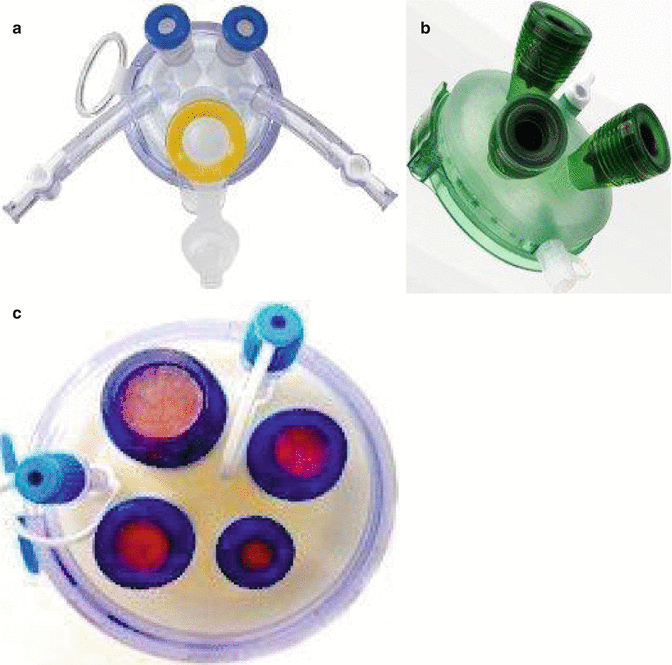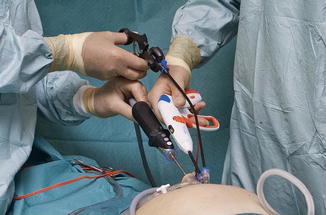Fig. 17.1
Cosmetic result immediately after surgery
17.2 Terminology
Various terminologies have been used to describe laparoscopic surgical procedures performed through a single incision or surgical site. In 2008, an international consortium of minimally invasive experts (the Laparoscopic Single-Site Surgery Consortium for Assessment and Research) met, with the goal of standardizing the terminology for academic communications and to avoid using industry and trade names. More than 10 terms to describe surgery through a single incision were identified (Table 17.1). The conclusion of this consortium was to utilize the term “LESS surgery” to describe all procedures performed in a minimally invasive manner through a single incision.
Table 17.1
Categorization for laparoendoscopic single site
Acronym | Full procedure name |
|---|---|
LESS | Laparoendoscopic single-site surgery |
Opus | One-port umbilical surgery |
NOTES | Natural orifice transluminal endoscopic surgery |
RSP | Robotic single-port surgery |
SILS | Single-incision laparoscopic surgery |
SIMIS | Single-incision minimally invasive surgery |
SLIT | Single laparoscopic incision transabdominal surgery |
SPA | Single-port access |
SPL | Single-port laparoscopy |
SPICES | Single-port incisionless conventional equipment-utilizing surgery |
U-LESS | Umbilical laparoendoscopic single-site surgery |
17.3 History of LESS
Simple gynecological procedures have been performed via the LESS approach for more than four decades. Three thousand six hundred cases of laparoscopic sterilization using LESS technique were reported by Wheeless et al. as early as 1973. The first hysterectomy was reported in 1991, but not until 2008 was a subsequent series of LESS gynecologic procedures reported in the literature. Since then, the number of procedures performed and described has grown exponentially (Fader et al. 2010; Escobar et al. 2010a, b; Chen et al. 2011; Cho et al. 2012; Fanfani et al. 2010; Yim et al. 2010), and in the last 2 years, several randomized trials have been published (Chen et al. 2011; Cho et al. 2012; Fagotti et al. 2011; Li et al. 2012).
A similar trend has been seen in general surgery. The first series of LESS cholecystectomy was described in 1997 and appendectomy in 2007. In urology, the first small series of nephrectomies were described in 2007. Randomized trials have now been performed.
17.4 LESS Instruments and Technology
17.4.1 Access Devices
The development of access devices, allowing passage of three or more instruments through a single small incision, together with channels for CO2 insufflation and smoke evacuation, has been the key to the fast development of this novel laparoscopic surgical modality.
Minimally invasive surgery requires an access device which allows passage of instruments and gas using the smallest possible incision. Devices using a retracting component consisting of an inner and outer ring with a thin plastic sleeve obtain this goal optimally since all space created by the incision can be used for instruments and specimen removal (TriPort 15, QuadPort, GelPOINT (Fig. 17.2)). In the newest devices, the valve system allows passage of the optic and instruments, comparable to standard trocars, and accommodates 5–15 mm instruments, including morcellator. Reusable devices on the market consist of a solid casing, enabling the optic and instruments to pass, which requires a relatively larger fascial incision.


Fig. 17.2
(a) TriPort 15. (b) QuadPort. (c) GelPOINT
17.4.2 Optics
LESS surgery can be performed with several types of optics. However, a small diameter scope (5 mm or smaller) reduces the abdominal trauma and enhances surgeon ergonomics by reducing the required length of the umbilical incision and limiting the extracorporeal instrument “sword fighting” that occurs with an “in-line” surgical approach. Conventional laparoscopes have a large extracorporeal profile with light cable perpendicular to the telescope, and this increases the risk of instrument clashing. This problem can be reduced with a 90° angle on the tip of the light cable. To further avoid instrument crowding and in-line visualization and increase the overview of the operative field, using a rotatable 30 or 45° laparoscope, preferably with a flexible tip, is critical. However, if accessible, a 5 mm, angled lower-profile camera system, with light cable in line with the shaft of the telescope, is also available (EndoEYE laparoscope (Olympus Germany/America) (Fig. 17.3).




